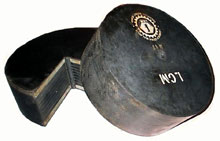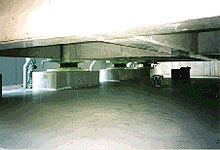|
| Earthquakes are one of the most destructive natural disasters
known to man. The conventional approach to protect structures
is to strengthen them so that they do not collapse in an earthquake.
For low to medium rise structures this approach is not effective
because the natural frequencies of these structures are within
the range of damaging earthquake frequencies which results in
an increase in the forces entering the structures.
An alternative method, known as base isolation, decouples the
structures from the earthquake forces and provides protection
for both the structures and contents. Among numerous designs
of base isolation systems available today, high damping natural
rubber bearings (HDNR) offer perhaps the simplest and the most
cost effective method of isolation and are relatively easy to
manufacture.
Rubber-steel laminated bearings for seismic isolation are designed
to provide sufficient vertical stiffness to support the load
of the structure and at the same time flexible in the horizontal
direction so as to accommodate the ground motion due to the
earthquake. Rubber-steel laminated bearings are designed to
give a mounted structure a horizontal natural frequency down
to 0.4 HZ (corresponding to a period of 2.5s).
Advantages of Steel Laminated Rubber Bearings over mechanical
structural support system are:
- Simple design
- Less or no maintenance is required
- No moving parts
- Resistant to environmental hazards
- Economical
- No additional damping mechanism required due to the inherent
damping characteristics of the rubber
Manufacturing process
- Preparation of rubber compound according to required
specification
- Preparation of metal surfaces
- Application of bonding agent
- Assembly
- Compression Moulding and Vulcanisation
- Performance test
|


Devastating effects of 1995 Kobe earthquake:
All collapsed bridge were installed with steel bearings, bridge
with rubber bearings did not collapse

Installed bearings underneath building
|
|




